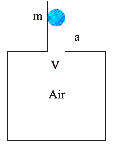Galileo’s law of odd numbers : “The distances traversed, during equal intervals of time, by a body falling from rest, stand to one another in the same ratio as the odd numbers beginning with unity [namely, 1: 3: 5: 7…...].” Prove it.Solution in Gujrati
Let us divide the time interval of motion of an object under free fall into many equal intervals τ and find out the distances traversed during successive intervals of time. Since initial velocity is zero, we have
y=−12gt2
Using this equation, we can calculate the position of the object after different time intervals, 0,τ,2τ,3τ... which are given in second column of Table 3.2. If we take (−1/2)gt2 as y0 - the position coordinate after first time interval τ, then third column gives the positions in the unit of y0. The fourth column gives the distances traversed in successive τs. We find that the distances are in the simple ratio 1: 3: 5: 7: 9: 11… as shown in the last column. This law was established by Galileo Galilei (1564-1642) who was the first to make quantitative studies of free fall.
Topper's Solved these Questions
- BOOK - NCERT GUJARATICHAPTER - MOTION IN A STRAIGHT LINEEXERCISE - EXERCISES23videos
MOTION IN A STRAIGHT LINE
- BOOK - NCERT GUJARATICHAPTER - MOTION IN A STRAIGHT LINEEXERCISE - ADDITIONAL EXERCISES5videos
MOTION IN A STRAIGHT LINE
- BOOK - NCERT GUJARATICHAPTER - MOTION IN A PLANEEXERCISE - EXCERCISES30videos
MOTION IN A PLANE
- BOOK - NCERT GUJARATICHAPTER - OSCILLATIONSEXERCISE - Additional Exercises6videos
OSCILLATIONS
Similar Questions
The angle of elevation of a bird sitting on top of a tree as seen from the point at a distance of 20m from the base of the tree is 60∘. Then, the height of the tree is ……..m
03:19View SolutionA boy standing on a stationary lift (open from above) throws a ball upwards with the maximum initial speed he can equal to 49 ms-1. How much time does the ball take to return to his hands ? If the lift starts moving up with a uniform speed of 5 ms−1 and the boy again throws the ball up with the maximum speed he can, how long goes the ball take to return to his hands ?
02:48View SolutionState , for each of the following physical quantities , if it is a scalar or a vector : volume , mass , speed , acceleration , density , number of moles , velocity , angular frequency , displacement , angular velocity .
03:19View SolutionAn air chamber of volume V has a neck area of cross section a into which a ball of mass m just fits and can move up and down without any friction (Fig.14.27). Show that when the ball is pressed down a little and released , it executes SHM. Obtain an expression for the time period of oscillations assuming pressure-volume variations of air to be isothermal [see Fig. 14.27].
 06:02View Solution
06:02View SolutionProve that the distances traversed during equal intervals of time by a body falling from rest, stand to one another in the same fatio as the odd mumbers beginning with unity [namely 1: 3: 5: …………….].
View SolutionThe ration of the distance traversed, in successive intervals of time by a body, falling from rest, are
05:56View Solutionगैलीलियो का विषम अंक संबंधित नियम : इस नियम के अनुसार ''विरामावस्था से गिरती हुई किसी वस्तु द्वारा समान समय अंतरालों में चली गई दूरियाँ एक दूसरे से उसी अनुपात में होती है जिस अनुपात में एक से प्रारंभ होने वाले विषम अंक [अर्थात 1:3:5:7,........]'' | इस कथन को सिध्द कीजिए |
View Solutionएक वस्तु किसी ऊंचाई से मुक्त रूप से विरामावस्था से नीचे गिरती है। सिद्ध कीजिए वस्तु द्वारा क्रमिक समान समय-अन्तरालों में तय दूरियों का अनुपात 1:3:5:7:………….. होगा।
06:06View Solutionगैलीलियो का विषम अंक संबंधित नियम : इस नियम के अनुसार "विरामावस्था से गिरती हुई किसी वस्तु द्वारा समान समय अंतरालों में चली गई दूरियाँ एक दूसरे से उसी अनुपात में होती हैं जिस अनुपात में एक से प्रारंभ होने वाले विषम अंक [अर्थात् 1: 3:5:7:.....]"। इस कथन को सिद्ध कीजिए।
04:23View SolutionGalileo’s law of odd numbers : “The distances traversed, during equal intervals of time, by a body falling from rest, stand to one another in the same ratio as the odd numbers beginning with unity [namely, 1: 3: 5: 7…...].” Prove it.
04:11View SolutionGalileo’s law of odd numbers : “The distances traversed, during equal intervals of time, by a body falling from rest, stand to one another in the same ratio as the odd numbers beginning with unity [namely, 1: 3: 5: 7…...].” Prove it.
04:20View SolutionGalileo’s law of odd numbers : “The distances traversed, during equal intervals of time, by a body falling from rest, stand to one another in the same ratio as the odd numbers beginning with unity [namely, 1: 3: 5: 7…...].” Prove it.
06:14View Solutionकिसी विरामावस्था वाले स्टैण्ड से गिरने वाले एक पिण्ड के द्वारा समय के समान अंतरालों में, गिरने पर उनके अनुपात इकाई से शुरू होकर विषम संख्याओं में होते हैं, जैसे-1: 3:5:7: ... इस नियम को प्रतिपादित किया था
07:27View SolutionProve that the distances traversed during equal intervals of time by a body falling from rest, stand to one another in the same ratio as the odd numbers beginning with unity [namely 1: 3: 5: …………….].
04:11View SolutionThe distance traversed, during equal intervals of time, of a body falling from rest, stand to one another in the same ratio as the odd numbers beginning with unity[ namely,1:3:5:7….].Prove it.
05:56View Solution

